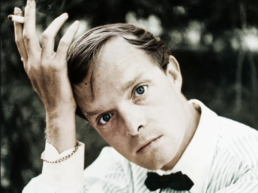These life stories may contain descriptions of childhood trauma and abuse, as well as images, voices and names of people now deceased. If you need help, you can find contact details for some relevant support services on our support page.
American writer, Truman Capote (1924-1984), was in kinship care as a child.
Truman Capote was born Truman Persons in New Orleans, Louisiana to sixteen-year-old Lillie Mae (nee Faulk) and twenty-six-year-old Archulus Persons. Lillie Mae neglected her baby son, often leaving him locked in a hotel suite while she went out, instructing hotel staff to ignore his screams.
I was only about two years old, but I was very aware of being locked in this hotel room… She had no one to leave me with. She had no money and she had nothing to do with my father. She would leave me locked in this hotel room when she went out in the evening with her beaux and I would become hysterical because I couldn’t get out of this room…
She then abandoned the child, leaving him with Faulk relatives while she “went to New York to pursue a dream of mingling in café society.”
The Faulks, who lived in a substantial white frame house on South Alabama Avenue in Monroeville, consisted of three unmarried women and their reclusive, unmarried brother, Bud.
While living in Monroeville, Truman became friends with next door neighbour Nelle Harper Lee, who later became the author of To Kill a Mockingbird (1960) using the name Harper Lee. Both children liked to read and write and shared estrangement from their mothers. Truman was left with a life-long sense of abandonment, and Nelle’s relationship with her mother was marred by her mother’s constant mood swings brought on by bipolar disorder.
Lillie Mae married Joseph Capote in New York in 1931. Lillie Mae became Nina and Joseph adopted Truman, who moved with the couple to New York in 1932.
At age eighteen, Truman Capote was “hired as a copyboy by the New Yorker magazine” but he later received money from his step-father so he could devote his time to writing fiction.
He was fortunate in that short stories appearing in the glossy women’s magazines paid well and could even launch a career—a condition that does not exist today (Long).
In 1945, Capote’s story Miriam brought him some notice and his first novel, Other Voices, Other Rooms (1948) earned some acclaim. “Breakfast at Tiffany’s” was published in 1958 and became one of Capote’s most popular stories. It was made into a film starring Audrey Hepburn three years later.
In Cold Blood, which was published in 1966, brought Truman Capote international and literary fame, and money. This ‘non-fiction novel’ was inspired by a New York Times article about an unsolved murder in Kansas. Although Capote spent a lengthy period in Kansas researching the story, there were those who believed the book was “fakery”.
Truman Capote’s later work was void of his early success, and eventually drug and alcohol dependence hampered his productivity. Two novels were published posthumously: Answered Prayers: The Unfinished Novel (1986) and Summer Crossing (2005).
References:
Kuiper, Kathleen. “Truman Capote America Author.” Encyclopaedia Britannica, 2019. https://www.britannica.com/biography/Truman-Capote
Long, Robert Emmet. Truman Capote. Bloomsbury Publishing (2014).
Schultz, William Todd. Tiny Terror: Why Trauma Capote (Almost) Wrote Answered Prayers. Oxford University Press (2011).
Image available here.
